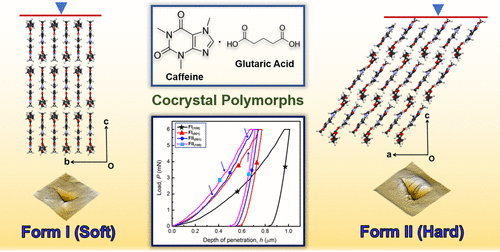当前位置:
X-MOL 学术
›
Cryst. Growth Des.
›
论文详情
Our official English website, www.x-mol.net, welcomes your feedback! (Note: you will need to create a separate account there.)
Structural Basis for Mechanical Anisotropy in Polymorphs of a Caffeine–Glutaric Acid Cocrystal
Crystal Growth & Design ( IF 3.8 ) Pub Date : 2020-09-15 , DOI: 10.1021/acs.cgd.0c01033 Manish Kumar Mishra 1 , Kamini Mishra 2 , Aditya Narayan 3 , C. Malla Reddy 4 , Venu R. Vangala 3
Crystal Growth & Design ( IF 3.8 ) Pub Date : 2020-09-15 , DOI: 10.1021/acs.cgd.0c01033 Manish Kumar Mishra 1 , Kamini Mishra 2 , Aditya Narayan 3 , C. Malla Reddy 4 , Venu R. Vangala 3
Affiliation

|
Insights into structure–mechanical property correlations in molecular and multicomponent crystals have recently attracted significant attention owing to their practical applications in the pharmaceutical and specialty fine chemicals manufacturing. In this contribution, we systematically examine the mechanical properties of dimorphic forms, Forms I and II, of a 1:1 caffeine–glutaric acid cocrystal on multiple faces using nanoindentation to fully understand their mechanical anisotropy and mechanical stability under an applied load. The higher hardness, H, and elastic modulus, E, of stable Form II has been rationalized based on its corrugated layers, higher interlayer energy, lower interlayer separation, and presence of more intermolecular interactions in the crystal structure compared to metastable Form I. Our results show that mechanical anisotropy in both polymorphs arises due to the difference in orientation of the same two-dimensional structural features, namely, the number of possible slip systems, and the strength of the intermolecular interactions with respect to the indentation direction. The mechanical properties results suggest that the 1:1 caffeine–glutaric acid cocrystal, metastable form (Form I) could be a suitable candidate with desired tablet performance to that of stable Form II. Overall, it demonstrates that the multiple faces of nanoindentation are critical to determine mechanical anisotropy and structure-mechanical property correlations. Further, the structural–mechanical property correlations aid in the selection of the best solid phase for macroscopic pharmaceutical formulation.
中文翻译:

咖啡因-谷氨酸共晶多晶型物的机械各向异性的结构基础
由于分子和多组分晶体的结构-机械性能相关性的实际应用,它们在制药和特殊精细化学品生产中的实际应用,最近引起了极大的关注。在这项贡献中,我们使用纳米压痕系统地研究了多个面上的1:1咖啡因-戊二酸共晶双晶型(晶型I和晶型II)的机械性能,以充分了解它们在施加载荷下的机械各向异性和机械稳定性。较高的硬度H和弹性模量E相较于亚稳晶型I,稳定型II的波纹层,更高的层间能量,更低的层间分离以及晶体结构中存在更多的分子间相互作用,已被合理化。我们的结果表明,两种多晶型物的机械各向异性是由相同的二维结构特征在方向上的差异,即可能的滑移系统的数量,以及相对于压痕方向的分子间相互作用的强度。力学性能结果表明,1:1咖啡因-戊二酸共晶亚稳形式(晶型I)可能是合适的候选药物,其片剂性能优于稳定的晶形II。总体,它表明纳米压痕的多个面对于确定机械各向异性和结构-机械性能的相关性至关重要。此外,结构-机械性质的相关性有助于宏观药物配方的最佳固相的选择。
更新日期:2020-10-07
中文翻译:

咖啡因-谷氨酸共晶多晶型物的机械各向异性的结构基础
由于分子和多组分晶体的结构-机械性能相关性的实际应用,它们在制药和特殊精细化学品生产中的实际应用,最近引起了极大的关注。在这项贡献中,我们使用纳米压痕系统地研究了多个面上的1:1咖啡因-戊二酸共晶双晶型(晶型I和晶型II)的机械性能,以充分了解它们在施加载荷下的机械各向异性和机械稳定性。较高的硬度H和弹性模量E相较于亚稳晶型I,稳定型II的波纹层,更高的层间能量,更低的层间分离以及晶体结构中存在更多的分子间相互作用,已被合理化。我们的结果表明,两种多晶型物的机械各向异性是由相同的二维结构特征在方向上的差异,即可能的滑移系统的数量,以及相对于压痕方向的分子间相互作用的强度。力学性能结果表明,1:1咖啡因-戊二酸共晶亚稳形式(晶型I)可能是合适的候选药物,其片剂性能优于稳定的晶形II。总体,它表明纳米压痕的多个面对于确定机械各向异性和结构-机械性能的相关性至关重要。此外,结构-机械性质的相关性有助于宏观药物配方的最佳固相的选择。


























 京公网安备 11010802027423号
京公网安备 11010802027423号